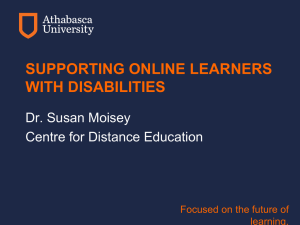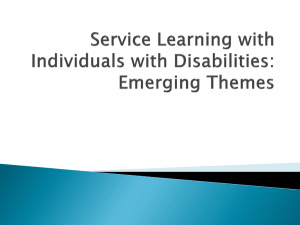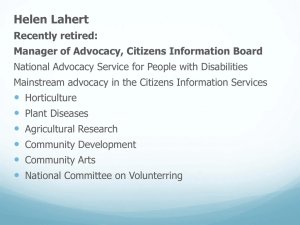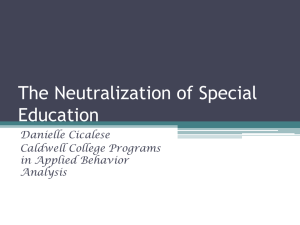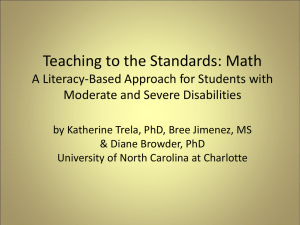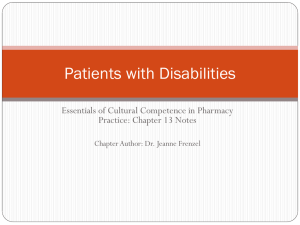AFN Intro and legal - Emergency Network Los Angeles
advertisement
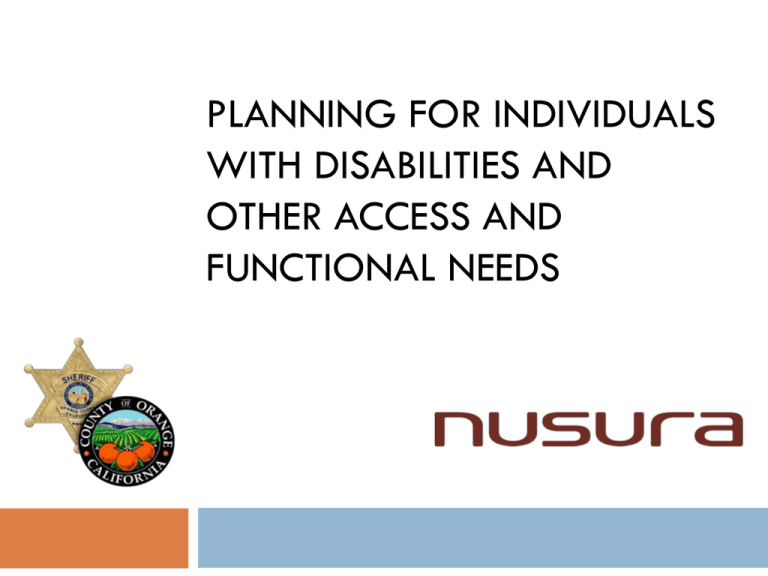
PLANNING FOR INDIVIDUALS WITH DISABILITIES AND OTHER ACCESS AND FUNCTIONAL NEEDS This presentation was created by Nusura, Inc. for the Orange County Sheriff’s Division of Emergency Management Facilitator Introductions June Kailes Andy Neiman Participant Introductions Name Title Agency/organization Role during an emergency Any burning issues Logistics Safety Electronics Breaks Contact Info Survey feedback Agenda Defining Access and Functional Needs Whole Community Planning Legal Considerations Defining Access and Functional Needs Defining Access and Functional Needs The difference between the right word and almost the right word is the difference between lightning and a lightning bug. Mark Twain Past Definitions Previously, Emergency Management community used the terms “special needs” and “special populations” Population and diagnosis-based criteria was used to identifying people who many need assistance: Older people People with hearing or vision impairment Non-English speakers Access and Functional Needs Identifies the functions that a person must perform in order to maintain health and wellbeing before, during, and after an emergency. Functions differ from needs in that functions refer to actions or tasks that an individual must take to have their needs met. Defining Access and Functional Needs, continued A function-based approach considers an individual’s vulnerability related to what they can do, not based on a perceived vulnerability based on a diagnostic category or population characteristic. Avoids generalization and stigmatization of population groups. Defining Access and Functional Needs, continued Recognizes that people may develop access and functional needs as a result of a disaster. Function-based approaches give emergency managers clear and actionable information. CMIST Updated Emphasizes 5 modified functional areas for all-hazards planning: Communication Maintaining Health Independence Support and Safety Transportation Supporting Independence Health Transportation Independence Safety & Support Communications Discussion What are some differences between a functionbased vs. population/diagnosis approach to defining need? What are some pros and cons to the function-based approach? How does the functions-based approach apply in planning? Whole Community Planning Whole Community Planning “My experience tells me if we wait and plan for people with disabilities after we write the basic plan, we fail.” Craig Fugate, FEMA Adminstrator Nothing about us without us People with disabilities and other AFN know best what they need. Identify, reach out to, and engage with the whole community, including individuals with disabilities and others with access and functional needs and the organizations the provide support or advocate on their behalf. Whole Community PlanningIdentify Partners Identify partners from the whole community Advocacy and support organizations Individual disability advocates Community organizations Faith-based organizations Work toward diversity, depth, and breadth of membership Ask partners who else should be included You don’t know what you don’t know Whole Community PlanningReaching Out Reaching out is more than meeting invites Ask potential partners how they’d like to be involved and strategies for facilitating involvement Identify barriers to participation When having meetings, ensure that: facilities are accessible accommodation is available (materials in large print, translation services, day care) Whole Community PlanningEngagement Engagement is more than asking for partners to review documents Ask partners what role they want to have Create two-way information exchanges Share responsibility for the real work Leverage the resources of the collective team Ask partners to solicit input from their constituencies Discussion How are you identifying, reaching out, and engaging with the whole community? What challenges have you had? How have you overcome them? What successes have you had? Legal Considerations Legal Considerations Emergency managers and planners have the responsibility to ensure services and facilities are accessible and compliant with relevant Federal, State, and local laws and regulations. Applicable Laws Americans with Disabilities Act of 1990 Stafford Act of 1988 Post Katrina Emergency Management Reform Act of 2006 Rehabilitation Act of 1973 Fair Housing Act Amendments of 1988 Architectural Barriers Act of 1968 Individuals with Disabilities Education Act of 1975 Telecommunications Act of 1996 Twenty-first Century Communications and Video Accessibility Act of 2010 Non-discrimination Concepts for Emergency Management Practice 1. Self-determination People with disabilities are the most knowledgeable about their own needs. 2. No “one-size-fits-all” People with disabilities do not all have the same needs or require the same assistance. Non-discrimination Concepts, continued 3. Equal Opportunity People with disabilities must have the same opportunities to benefit from emergency programs, services, and activities as people without disabilities. 4. Inclusion People with disabilities have the right to participate in and receive the benefits of emergency programs, services, and activities provided by governments, private businesses, and nonprofit organizations. Non-discrimination Concepts, continued 5. Integration Emergency programs, services, and activities typically must be provided in an integrated setting. 6. Physical Access Emergency programs, services, and activities must be provided at locations that all people can access, including people with disabilities. Non-discrimination Concepts, continued 7. Equal Access People with disabilities must be able to access and benefit from emergency programs, services, and activities equal to the general population. 8. Effective Communication People with disabilities must be given information that is comparable in content and detail to that given to the general public. It must also be accessible, understandable and timely. Non-discrimination Concepts, continued 9. Program Modification People with disabilities must have equal access to emergency programs and services, which may entail modifications to rules, policies, practices, and procedures. 10. No Charge People with disabilities may not be charged to cover the costs of measures necessary to ensure equal access and nondiscriminatory treatment. ADA Compliance Litigation Project Civic Access A DOJ program which seeks to remove physical and communications barriers that prevent people with disabilities from participating fully in community life Has resulted in 207 settlements, including several a number of disaster shelter-related settlements: Fairfax County, Virginia Pearl River County, Mississippi ADA Compliance Litigation In addition to Civic Access litigation, a number of key disaster-related cases have impacted emergency management planning, preparedness, response, and recovery City and County of Los Angeles New York, NY Take Action Review your plans for gaps Create an Action Plan Break it down into smaller steps Create timeline and deadlines for addressing gaps Document and codify things you are already doing Leverage existing resources and your whole community partners Collaborate Seek grant funding and get support Questions? Discussion What AFN planning issues are you concerned with? Share your thoughts! Thank You! Please complete the course feedback form before you leave


